Like a Hamster Ball on the Water
While in Chongqing we went to a carnival by the river side. There was one event that got our attention immediately. It looked like people running around inside giant hamster balls on top of water. What fun!
A thought immediately came to my mind, though: how do they get fresh air in those things? It turns out they don’t. They fill the balls with a big blower, then zipper them shut and put a big piece of tape over the zipper to keep it water tight. You’re only allowed in for 5 minutes, after which the carnies reel you in (the ball is tethered to the shore). It cost 10 RMB.
Anyway, I had to have a go. Here’s my ball getting inflated.
Once my ball was full, I surged into the water with a vicious plop.
I was very graceful.
For some reason, a child was laughing at me.
I set out to destroy her.
I did not succeed.
I decided to let her live and crawled off elsewhere.
I liked the challenge of trying to stand up, and I was able to do it several times.
But not for long.
I eventually decided to chill out for a while because all my physical exertion must have been using up my limited oxygen pretty fast*. I emerged very satisfied.
Overall, a very fun experience.
*How long should the oxygen in one of those balls last? I’m 194 cm tall, so I guess the diameter of the sphere is just over 2 meters or so. Anyone know? I’m wondering how close to 5 minutes it is.




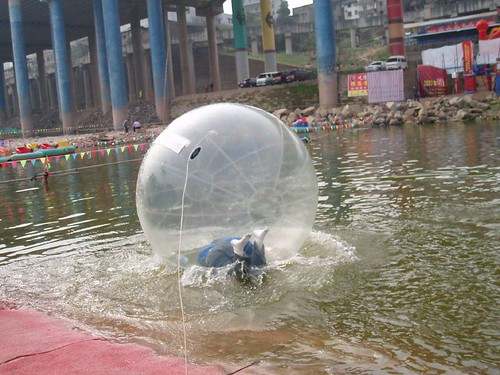
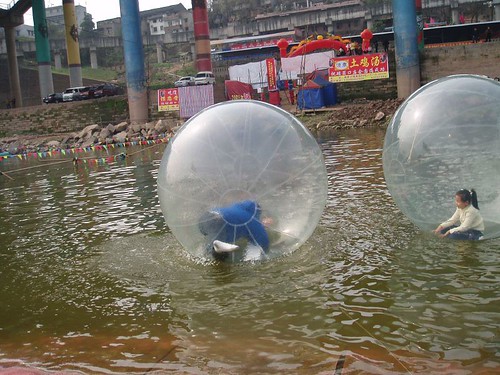
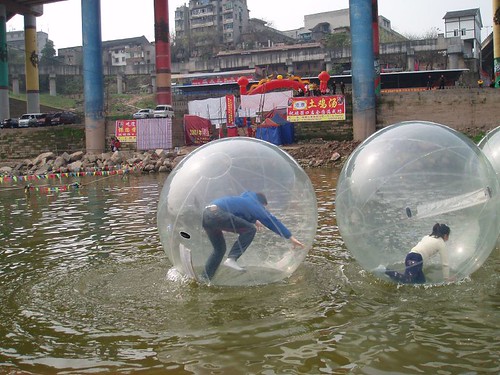
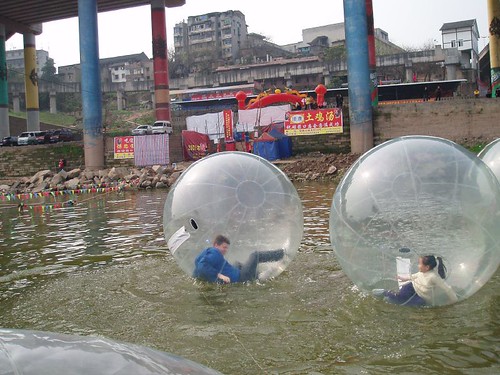
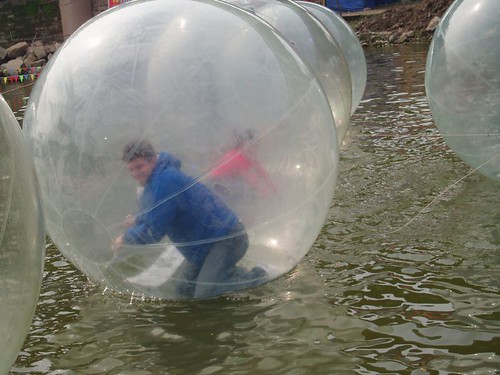


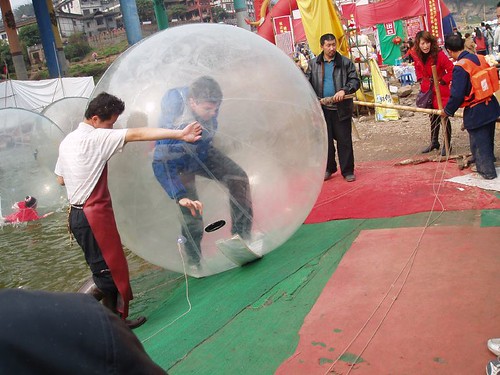
That’s freakin’ awesome.
Theoretically, it’s much longer than 5mins.
First, the total volume of air in the ball is approx. 33500 liters.
Secondly, the normal breathing volume in a minute is 5-8 liters.
Thirdly, you are doing heaving rolling activity so your normal breathing volume would be more than 8 liters/minute. the oxygen level would be exponentially decreased as the activity remained because the ball was sealed.
if you assume the first minute you breathed 8 liters, the oxygen consumed was 8 * 21% and if you assume the next minute you will be getting more because the air isnot moving and the amount of oxygen you got from one breath is less than the first time, you probably would consumed 16 * 21%. so 32 * 21% for the third minute, for the fourth, 128 * 21% for the fifth
now you got 33500 * 21% liters of oxygen, so 33500 * 21% is way enough for the total consumption, which is 8 * 21% + 16 * 21% + 32 * 21% + 64 * 22% + 128 * 21%
But people would be panic and psycologically out of oxygen because of the fact that he is in a sealed ball I guess.
i think the word ” ball’ is somewhat sensitive. I should have put “balls” instead.
Marco,
Thanks for doing those calculations. But why not just determine the approximate total amount of oxygen in the ball (apparently 33500 L * 21% = 7035 L), then set an average consumption per minute (maybe 10 L?) to determine the total minutes of oxygen in the ball?
Only problem is those figures give you almost half a day of oxygen in the ball, which has got to be too long.
We should probably also figure in the volume of air displaced by one’s body inside the ball.
you can do that too and the reason why I didn’t was because somehow it doesn’t show the displacement of oxygen. Even though mine was not an good example showing this , I at least assume that displacement has something to do with exponentation.
Yeah! We’ve had these here in Liuzhou for a while. Great fun!
Marco,
I think your calculations are off. The volume of a sphere is (4/3)(pi)(r^3). Your calculation uses the diameter, not the radius. The volume of a two-meter tall sphere is 4180 liters.
Of course, John’s in the bubble, so the space he’s occupying doesn’t have air in it. Using the approximation given here and guessing that John is about 90kg, he takes up about 90 liters, leaving 4090 liters for air.
At sea level air is about 21% oxygen, so in that 4090 liters of air there are about 859 liters of oxygen. According to this estimate, humans consume an average of 1900 liters per day of oxygen, or 79 liters per hour, meaning that the oxygen could theoretically last for nearly 11 hours (that would be if you were sitting there quietly, I guess, but even twice the oxygen consumption would give you far longer than 5 minutes).
Of course with every breath the partial pressure of oxygen in the ball’s air would drop, so you’d starting having problems long before the oxygen totally ran out, but five minutes is probably more driven by profit than the risk of customer asphyxiation.
I think that even as the partial pressure fell, though, your oxygen consumption would remain the same, you’d just breath harder to get it, until the oxygen level was reduced to such a point that no amount of breathing harder would make up the oxygen deficit your body was generating, at which point bad things would start to happen.
thanks for pointing that out. I got a nightmare junior high math teacher!
estimation is just estimation. it’s quite to have a conlusive outcome unless all the conditions are given.
john
what’s the ball made of? do you think the reason why it doesn’t submerge was due to its large contact surface with the water?
“do you think the reason why it doesn’t submerge was due to its large contact surface with the water?”
– do a Google search using ‘Archimedes’ as your search criteria.
Marco,
As I understand it, for the ball to sink (displacing 4180 L of water), the ball would have to be heavier than 4180 L of water. That’s 4180 kg (9215 pounds). As John B guessed, I’m 90 kg.
Have you ever tried forcing even a relatively small beach ball under water? It’s surprisingly difficult.
I’m surprised you wife didn’t cut the string.
That looks like A LOT of fun, the kid at peace while you flail away is a National Geographic cover shot. You know this wouldn’t pass some health code in the U.S.!
You guys didn’t factor in that John is expelling CO2 which would alter the ratio of O2 in the bubble. I predict after 5 minutes he would suffer high-altitude sealed bubble delirium syndrome, HASBDS, and start farting.
I want to do that tooo!!!
sorry to get all anal over this but the limiting factor is not at all the oxygen consumed but rather the carbon dioxide produced. carbon dioxide inhibits breathing at surprisingly low levels.
What a great intuition !
You made one of the most relevant interpretation of the Shanghai stock exchange I ever seen.
Tuur,
It’s not anal at all! I want to know. So yeah, that’s a crucial bit of info.
From Answers.com:
OK, so assuming the air inside the ball started at 21% oxygen and 0.04% CO2, and exhaled air is 4.5% CO2, when should the air in the ball start getting hard to breathe?
This would be a fun SAT question.
From the Answers link, a person produces 450L of CO2 per day (a bit less than 1kg), or 18.75L per hour. Concentration in the 4090L ball would increase from 0.04% to a toxic 5% in 10.8 hours. But you’d pass the 0.5% TLV at 1 hour and the “foul air” 1% concentration at 2 hours.
It’d actually be somewhat quicker in your situation, since the daily average presumably includes sleeping.
using the figures from john b. and john’s posts, we have:
AIR is 21% O2
.04% CO2
the ball has 4090 L of AIR
859 L of O2
1.636 L of CO2
We inhale at a rate of 79 L of O2 / hr
inverting the o2/air ration above, we get:
We inhale at a rate of 376 L of AIR / hr
.1504 L of CO2 / hr
assuming we exhale as much volume as we inhale, this means:
we exhale 376 L of AIR / hr
if we exhale air with a 4.5% concentration of CO2, then:
we exhale 17 L of CO2 / hr
(this assumes the proportion of co2 in exhaled air does not rise as the atmospheric concentration rises, which is probably false, but would only serve to increase our estimate of the concentration of co2 in the bubble, which would shorten the safe period)
now, if we inhale .1504 L of CO2/hr, and exhale 17 L of CO2/hr, then our net increase in the amount of co2 in the bubble is:
16.75 L of CO2 added to bubble / hr (being conservative with respect to rounding)
respecting the laws of conservation, we can probably assume this equates to a comparable decrease of O2 in the bubble in the same period.
also remember there was 1.636 L of CO2 in the bubble to begin with, so, after one hour, we still have 4090 L of air, but now have 16.75 + 1.636 = 18.39 L of co2, giving:
concentration of CO2 in bubble after 1 hr of breathing: .45 %
which is just about the threshold for safety (.5%) proscribed.
assuming breathing gets less efficient as activity rises, a five minute limit doesn’t seem unreasonable.
On second thought, maybe it wouldn’t be such a fun SAT question. It’d qualify as one of those, “who the *$%@ thought of this?” or “how does this apply to my life?” type of reasonings by a test taker.
john
the point when you start feeling hard to breathe has something to do with pulmonary pressure versus ball air pressure. That’s the basics of physiology. It’s getting very complicated that way. I will consider this as an alternative for my dissertation.
These calculations are all fine and well until the ball springs a leak, thus reducing both the oxygen inside the ball and the amount of displaced water needed to keep it afloat.
This was a hilarious post! One of the reasons I love China. Where else can you get sealed in a ball for less than $1.50? This couldn’t happen in the States, the insurance companies wouldn’t allow it! I bet you didn’t even have to sign away your life, just throw down some money and off you go. 🙂
we do have those in the states. i live in lynn, massachusetts they usually have them at the carnivals in a big pool . usually its about 5.00 dollars . i don’t know how long though .
I had a friend do this at a park about an hour and a half from Fuyang, China – where I used to live. He used up all of his oxygen and when they let him out he vomitted eveywhere. He said it was fun, but I don’t think he will do it again. Heh. And after hearing his story – I’m a bit afraid myself.
God forbid the ball breaks and you fall in that radioactive green sludge they call “water.”
[…] And, coolest of all, some kids were rolling around on the water in those giant bubbles I wrote about before. […]
I have tried it . Its really hard 2 stand up but home made them ?
i have always wanted something like this to happen and it has THEY ARE AWSUME X
[…] looking very beautiful. There was also a fair amount of random park-like stuff, including the inflatable bubbles on the pond, and even a stage for performances, which radiated loud annoying techno-pop (not the […]
if there was a hole in the ball the ball would deflate. then they wouldnt be able to swim because of the enclosing walls of the ball!
Haha i went in one of those in wales lol i thought there was holes where the handles was until i realized the was covered up lol.I went in one and it was impossible to walk in them i kept falling lool
These look awesome and would be great for a campaign my school might run. Where could we get hold of these and what kind of prices are we looking at?
how much does it cost? after seeing all the videos of people falling, i really wanted one. It seems like so much fun, only if i knew the cost.
Do you know where I can buy running balls?
Dude, what r u? BRITISH?!?!?!
how much does it cost? I really want to buy one!!!!!!!!!!!!!!!